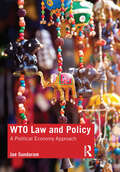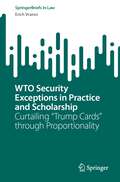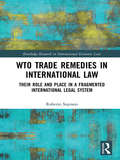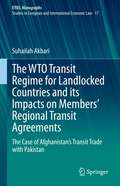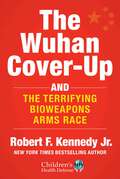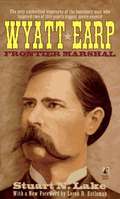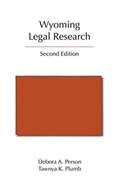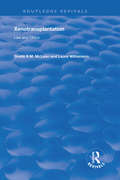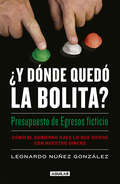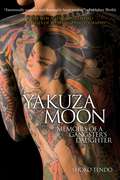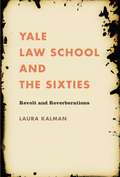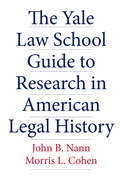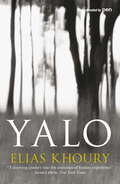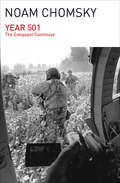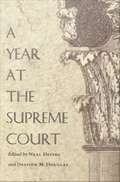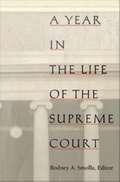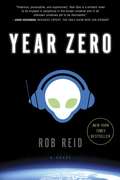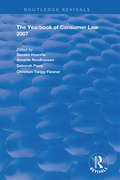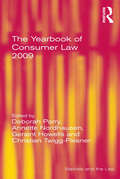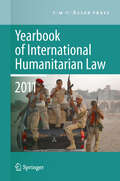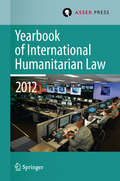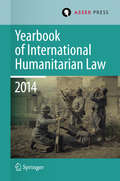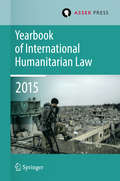- Table View
- List View
WTO Law and Policy: A Political Economy Approach
by Jae SundaramWTO Law and Policy presents an authoritative account of the emergence of the World Trade Organization (WTO) and the basic principles and institutional law of the WTO. It explores how political economy has shaped the WTO’s legal philosophy and policies, and provides insights into how international trade law at the WTO has developed. This textbook examines the legal obligations of the Member States of the WTO under the multilateral trade agreements, the legal remedies available under the rules-based dispute settlement system, and incorporates the most relevant case laws from WTO’s jurisprudence. It outlines several key contemporary issues which the WTO faces as well as areas that need reforming. Each chapter covers a specific topic in relation to the framework and functionality of the WTO, with particular focus on the legal aspects of the multilateral trade order. The book is guided by the legal pronouncements of the Dispute Settlement Body (Panels and Appellate Body), and the commentaries on the interpretation of the provisions of the covered agreements. This book is ideal for all students studying international trade law, including those coming to international law, international trade law, and WTO law for the first time.
The WTO Regime on Government Procurement: Challenge and Reform
by Sue Arrowsmith Robert D. AndersonOriginally an important but relatively obscure plurilateral instrument, the WTO Agreement on Government Procurement (GPA) is now becoming a pillar of the WTO system as a result of important developments since the Uruguay Round. This collection examines the issues and challenges that this raises for the GPA, as well as future prospects for addressing government procurement at a multilateral level. Coverage includes issues relating to pending accessions to the GPA, particularly those of developing countries with a large state sector such as China; the revised (provisionally agreed) GPA text of 2006, including provisions on electronic procurement and Special and Differential Treatment for Developing Countries; and procurement provisions in regional trade agreements and their significance for the multilateral system. Attention is also given to emerging issues, especially those concerning environmental, social and SME policy; competition law; and the implications of the recent economic crisis.
WTO Security Exceptions in Practice and Scholarship: Curtailing “Trump Cards” through Proportionality (SpringerBriefs in Law)
by Erich VranesThis book offers an in-depth analysis of the WTO security exceptions and relevant rulings by WTO dispute settlement panels. The WTO security exceptions are commonly regarded as the "box of Pandora" of the WTO system, since WTO Member States can invoke them in order to justify trade restrictions violating WTO law which they consider necessary for their essential security interests. The Members of the WTO and the GATT 1947 have hesitated for decades to rely on these security exceptions. In recent years, however, these clauses have been invoked for the first time in high-profile disputes involving Russia and Ukraine, Saudi Arabia and Qatar, as well as the US, China, the EU and other nations. This has been regarded as the turn of an era in view of the risk that the security exceptions could be instrumentalized to undermine the WTO and the international economic governance system more generally. This study therefore thoroughly analyses the WTO panel reports issued in these landmark cases. It also explains the geopolitical relevance of the increasing invocation of security clauses and argues that the legally and methodologically sound application of the WTO security exceptions, which have often been regarded as “self-judging” provisions, requires a proportionality analysis encompassing tests of the suitability and necessity of the trade measures to be justified under these truly exceptional clauses.
WTO Trade Remedies in International Law: Their Role and Place in a Fragmented International Legal System (Routledge Research in International Economic Law)
by Roberto SopranoWorld Trade Organisation (WTO) trade remedies (antidumping, anti-subsidy and safeguard agreements) are instruments used by WTO members to counter the economic injury caused by dumping, subsidies and the sudden and unforeseen increased imports. They are exceptions to the WTO principle of free trade and to the prohibition for States to react unilaterally to protect their own rights and interests, and as a result they have been accused by some as being the new tools of protectionism. This book analyses of the role and principles of WTO trade remedies in international law. In particular, it focuses on their aims, their structure, and their position within the WTO and more in general, the international legal system. The book considers trade remedies in light of fragmentation theories of international law and addresses the question how, and to what extent WTO law reflects and influences public international law.
The WTO Transit Regime for Landlocked Countries and its Impacts on Members’ Regional Transit Agreements: The Case of Afghanistan’s Transit Trade with Pakistan (European Yearbook of International Economic Law #17)
by Suhailah AkbariThis book assesses Afghanistan’s transit trade with Pakistan in the context of WTO transit regime for landlocked countries and its impacts on Members’ regional transit agreements. The key questions this book seeks to answer are the extent Afghanistan can benefit from WTO transit rules in demanding freedom of transit through the territory of Pakistan, how these rules influence the transit agreement concluded between Afghanistan and Pakistan, and finally how useful it would be to challenge Pakistan under the WTO dispute settlement system for its failure to provide Afghanistan freedom of transit and free access to and from the sea.
The Wuhan Cover-Up: And the Terrifying Bioweapons Arms Race (Children’s Health Defense)
by Robert F. Kennedy Jr.&“RFK Jr. exposes the decades of lies.&”—Luc Montagnier, Nobel laureate From the New York Times, Wall Street Journal, USA Today, and Publishers Weekly bestselling author of The Real Anthony Fauci comes an explosive exposé of the cover-up behind the true origins of COVID-19. &“Gain-of-function&” experiments are often conducted to deliberately develop highly virulent, easily transmissible pathogens for the stated purpose of developing preemptive vaccines for animal viruses before they jump to humans. More insidious is the &“dual use&” nature of this research, specifically directed toward bioweapons development. The Wuhan Cover-Up pulls back the curtain on how the US government's increase in biosecurity spending after the 2001 terror attacks set in motion a plan to transform the National Institute of Allergy and Infectious Diseases (NIAID), under the direction of Dr. Anthony Fauci, into a de facto Defense Department agency. While Dr. Fauci zealously funded and pursued gain-of-function research, concern grew among some scientists and government officials about the potential for accidental or deliberate release of weaponized viruses from labs that might trigger worldwide pandemics. A moratorium was placed on this research, but true to form, Dr. Fauci found ways to continue unperturbed—outsourcing some of the most controversial experiments offshore to China and providing federal funding to Wuhan Institute of Virology's (WIV's) leading researchers for gain-of-function studies in partnership with the Chinese military and the Chinese Communist Party. Robert F. Kennedy Jr.'s meticulously researched and rigorously sourced analysis leads readers on a staggering journey to learn about: the key enablers and henchmen pushing for gain-of-function research the economic motives behind gain-of-function research successfully engineered &“chimeric viruses&” that can infect and kill humans the coordinated effort to silence speculation of COVID-19&’s laboratory genesis the complicity of scientific journals to hide the origins of COVID-19 the role of the Wuhan Institute of Virology in China&’s biowarfare/biodefense program the relationships between US health, military, and intelligence bureaucracies and scientists and their Chinese counterparts the roles of Bill Gates and Sir Jeremy Farrar in orchestrating a global cover-up The Wuhan Cover-Up unveils a global conspiracy of epic proportion and lethal consequence.
Wyoming Legal Research
by Debora A. Person Tawnya K. PlumbThe second edition of Wyoming Legal Research maintains the same practical research techniques and solid focus on Wyoming resources as the first edition. <p><p>The text, geared towards students and members of the general public with little to no experience in researching legal issues, is also appropriate for practicing attorneys wishing to identify the most effective coverage among specific legal resources. <p><p>This edition updates searching capabilities within the latest platforms of major commercial legal databases Lexis and Westlaw, with added coverage of newer products such as Bloomberg Law and Casemaker. The text includes information regarding access to freely-available primary and secondary legal resources on the internet as well as Wyoming-specific web sites and treatises. It explores the administrative process more deeply and updates Wyoming and federal legislative history features within both commercial and free databases. <p><p>The chapter on citating options, commonly known as Shepardizing, has been rewritten, as has the legal citation chapter which now references the revised editions of The Bluebook and ALWD Citation Manual. Images and examples have been updated throughout. Wyoming Legal Research remains an essential text for learning and practicing legal research in the state.
Xenotransplantation: Law and Ethics (Routledge Revivals)
by Sheila A. McLeanOriginally published in 2005. One of the leading causes of death is organ failure, that is, when one or other of the organs that run the machine we call the body gives out. However, whereas with a machine spare parts can usually replace faulty parts, in the case of humans the supply of these is limited as it is dependent on organs being obtained from living or dead donors. Due to the limitations of supply, increasing attention is being paid to alternative schemes for obtaining organs. One of these possibilities is xenotransplantation: using organs from animals. In this book, the authors examine the legal and ethical issues surrounding xenotransplantation and consider the implications for the future. As they point out, xenotransplantation represents a major deviation from standard medical practice and the possibility of transplantation of large segments of tissue, or whole organs, from animals into humans poses an entirely novel set of considerations - ethical, legal and scientific - which it is necessary to evaluate and understand.
Xenotransplantation and Risk: Regulating a Developing Biotechnology
by Sara FovargueSome developing biotechnologies challenge accepted legal and ethical norms because of the risks they pose. Xenotransplantation (cross-species transplantation) may prolong life but may also harm the xeno-recipient and the public due to its potential to transmit infectious diseases. These trans-boundary diseases emphasise the global nature of advances in health care and highlight the difficulties of identifying, monitoring and regulating such risks and thereby protecting individual and public health. Xenotransplantation raises questions about how uncertainty and risk are understood and accepted, and exposes tensions between private benefit and public health. Where public health is at risk, a precautionary approach informed by the harm principle supports prioritising the latter, but the issues raised by genetically engineered solid organ xenotransplants have not, as yet, been sufficiently discussed. This must occur prior to their clinical introduction because of the necessary changes to accepted norms which are needed to appropriately safeguard individual and public health.
¿Y dónde quedó la bolita?: Cómo el gobierno hace lo que quiere con nuestro dinero
by Leonardo Nuñez¿Sabes qué hace realmente el gobierno con nuestro dinero? ¿Por qué el gobierno nos dice que gasta de una manera y lo hace de otra? ¿Por qué el gasolinazo es una pésima decisión del gobierno? ¿En qué se gasta realmente el dinero de los mexicanos? Este libro pretende dar respuesta a estas y otras preguntas y, más importante aún, ofrece a los ciudadanos las herramientas necesarias para conocer la situación real del gasto en cualquier tema. Para la mayoría de los ciudadanos esto es un misterio. Cuando alguien quiere conocer cómo se gasta, de manera lógica acude a las cifras del Presupuesto de Egresos de la Federación (PEF), eso que cada año aprueban los diputados y debería indicar cuánto y cómo se gastará. Sin embargo, aquí sólo hay verdades a medias. El 30 de abril de cada año aparece otro documento que revela historias muy diferentes y recibe muy poca atención: la Cuenta Pública. Al revisarla encontraremos, por ejemplo, que en 16 años de vida "democrática" nuestro gobierno ha gastado 4.1 billones de pesos más de lo que nos había dicho (casi 20% del PIB o 100 veces el presupuesto de la UNAM); que en 2016 ¡se usaron 613 mil millones de pesos más de los presupuestados!, que una cuarta parte de todo lo que se gasta termina en lugares diferentes a los que creeríamos, o que debimos saber de los desfalcos de Javier Duarte en Veracruz, al menos, desde 2013. Así las cosas, el uso de nuestros recursos es como el juego popular: en dónde quedó la bolita. ¡Urge detener los casos de corrupción y uso inadecuado del dinero público! ¡Es tiempo de cambiar las cosas!
Yakuza Moon: Memoirs of a Gangster's Daughter
by Louise Heal Shoko TendoYakuza Moon is the shocking, yet intensely moving memoir of 37-yearold Shoko Tendo, who grew up the daughter of a yakuza boss. Tendo lived her life in luxury until the age of six, when her father was sent to prison, and her family fell into terrible debt. Bullied by classmates who called her "the yakuza girl," and terrorized at home by a father who became a drunken, violent monster after his release from prison, Tendo rebelled. A regular visitor to nightclubs at the age of 12, she soon became a drug addict and a member of a girl gang. By the age of 15 she found herself sentenced to eight months in a juvenile detention center.Adulthood brought big bucks and glamour when Tendo started working as a bar hostess during Japan’s booming bubble economy of the nineteen- eighties. But among her many rich and loyal patrons there were also abusive clients, one of whom beat her so badly that her face was left permanently scarred. When her mother died, Tendo plunged into such a deep depression that she tried to commit suicide twice.Tendo takes us through the bad times with warmth and candor, and gives a moving and inspiring account of how she overcame a lifetime of discrimination and hardship. Getting tattooed, from the base of her neck to the tips of her toes, with a design centered on a geisha with a dagger in her mouth, was an act that empowered her to start making changes in her life. She quit her job as a hostess. On her last day at the bar she looked up at the full moon, a sight she never forgot. The moon became a symbol of her struggle to become whole, and the title of the book she wrote as an epitaph for herself and her family.
Yale Law School and the Sixties
by Laura KalmanThe development of the modern Yale Law School is deeply intertwined with the story of a group of students in the 1960s who worked to unlock democratic visions of law and social change that they associated with Yale's past and with the social climate in which they lived. During a charged moment in the history of the United States, activists challenged senior professors, and the resulting clash pitted young against old in a very human story. By demanding changes in admissions, curriculum, grading, and law practice, Laura Kalman argues, these students transformed Yale Law School and the future of American legal education.Inspired by Yale's legal realists of the 1930s, Yale law students between 1967 and 1970 spawned a movement that celebrated participatory democracy, black power, feminism, and the counterculture. After these students left, the repercussions hobbled the school for years. Senior law professors decided against retaining six junior scholars who had witnessed their conflict with the students in the early 1970s, shifted the school's academic focus from sociology to economics, and steered clear of critical legal studies. Ironically, explains Kalman, students of the 1960s helped to create a culture of timidity until an imaginative dean in the 1980s tapped into and domesticated the spirit of the sixties, helping to make Yale's current celebrity possible.
The Yale Law School Guide to Research in American Legal History (Yale Law Library Series in Legal History and Reference)
by John B. Nann Morris L. CohenThe study of legal history has a broad application that extends well beyond the interests of legal historians. An attorney arguing a case today may need to cite cases that are decades or even centuries old, and historians studying political or cultural history often encounter legal issues that affect their main subjects. Both groups need to understand the laws and legal practices of past eras. This essential reference is intended for the many nonspecialists who need to enter this arcane and often tricky area of research.
Yalo
by Elias KhouryYalo was a soldier on one of the many sides in Lebanon's sectarian civil war, before becoming a deserter and a thief, a nightwatchman in Paris, an arms smuggler, and then a rapist. And then he falls in love with his victim - who turns him in to the police. This novel is a modern Thousand and One Nights, a series of confessions extracted under torture, a recitation of all of his memories, all his sorrows, all his guilt - and of the other crimes his interrogators have him confess to. Beirut and the legacy of the wars of the Middle East are the texture of Elias Khoury's extraordinary literary achievement.
Year 501: The Conquest Continues (Chomsky Perspectives Ser. #Vol. 63)
by Noam Chomsky"The great work of subjugation and conquest" has changed little over the years. Analyzing Haiti, Latin America, Cuba, Indonesia, and even packets of the Third World developing in the United States. Noam Chomsky draws parallels between the genocide of colonial times and the murder and exploitation associated with modern-day imperialism.
A Year at the Supreme Court
by Neal Devins Davison M. DouglasThe United States Supreme Court's 2002-03 term confounded Court watchers. The same Rehnquist Court that many had seen as solidly conservative and unduly activist--the Court that helped decide the 2000 presidential election and struck down thirty-one federal statutes since 1995--issued a set of surprising, watershed rulings. In a term filled with important and unpredictable decisions, it upheld affirmative action, invalidated a same-sex sodomy statute, and reversed a death sentence due to ineffective assistance of counsel. With essays focused on individual Justices, Court practices, and some of last year's most important rulings, this volume explores the meaning and significance of the Court's 2002-03 term. Seasoned Supreme Court advocates and journalists from The New Republic, The Los Angeles Times, Newsweek, National Journal, Slate, and Legal Times grapple with questions about the Rehnquist Court's identity and the Supreme Court's role in the political life of the country. Some essays consider the role of "swing" Justices Sandra Day O'Connor and Anthony Kennedy within a Court that divides 5-4 more than any other group of Justices in the nation's history. Others examine the political reaction to and legal context of the Court's Lawrence v. Texas decision declaring a Texas law criminalizing homosexual sodomy unconstitutional. Contributors analyze the Court's rulings on affirmative action and reassess its commitment to states' rights. Considering the Court's practices, one advocate explores the use and utility of amicus curiae, or "friend of the court" briefs, while another reflects on indications of an increased openness by the Court to public scrutiny. Two advocates who argued cases before the Court--one related to hate speech and the other to a "three strikes and you're out" criminal statute--offer vivid accounts of their experiences. Intended for general readers, A Year at the Supreme Court is for all those who want to understand the Rehnquist Court and its momentous 2002-03 term. Contributors Erwin Chemerinsky Neal Devins Davison M. Douglas David J. Garrow Dahlia Lithwick Tony Mauro Carter Phillips Ramesh Ponnuru Jeffrey Rosen David G. Savage Rodney A. Smolla Stuart Taylor Jr.
A Year in the Life of the Supreme Court
by Paul Barrett Richard Carelli Marcia Coyle Lyle Denniston Aaron Epstein Kay Kindred Tony Mauro David Savage Stephen WermielDespite its importance to the life of the nation and all its citizens, the Supreme Court remains a mystery to most Americans, its workings widely felt but rarely seen firsthand. In this book, journalists who cover the Court--acting as the eyes and ears of not just the American people, but the Constitution itself--give us a rare close look into its proceedings, the people behind them, and the complex, often fascinating ways in which justice is ultimately served. Their narratives form an intimate account of a year in the life of the Supreme Court. The cases heard by the Surpreme Court are, first and foremost, disputes involving real people with actual stories. The accidents and twists of circumstance that have brought these people to the last resort of litigation can make for compelling drama. The contributors to this volume bring these dramatic stories to life, using them as a backdrop for the larger issues of law and social policy that constitute the Court's business: abortion, separation of church and state, freedom of speech, the right of privacy, crime, violence, discrimination, and the death penalty. In the course of these narratives, the authors describe the personalities and jurisprudential leanings of the various Justices, explaining how the interplay of these characters and theories about the Constitution interact to influence the Court's decisions. Highly readable and richly informative, this book offers an unusually clear and comprehensive portrait of one of the most influential institutions in modern American life.
Year Zero: A Novel
by Rob ReidAn alien advance party was suddenly nosing around my planet. Worse, they were lawyering up. . . . In the hilarious tradition of The Hitchhiker's Guide to the Galaxy, Rob Reid takes you on a headlong journey through the outer reaches of the universe--and the inner workings of our absurdly dysfunctional music industry. Low-level entertainment lawyer Nick Carter thinks it's a prank, not an alien encounter, when a redheaded mullah and a curvaceous nun show up at his office. But Frampton and Carly are highly advanced (if bumbling) extraterrestrials. And boy, do they have news. The entire cosmos, they tell him, has been hopelessly hooked on humanity's music ever since "Year Zero" (1977 to us), when American pop songs first reached alien ears. This addiction has driven a vast intergalactic society to commit the biggest copyright violation since the Big Bang. The resulting fines and penalties have bankrupted the whole universe. We humans suddenly own everything--and the aliens are not amused. Nick Carter has just been tapped to clean up this mess before things get ugly, and he's an unlikely galaxy-hopping hero: He's scared of heights. He's also about to be fired. And he happens to have the same name as a Backstreet Boy. But he does know a thing or two about copyright law. And he's packing a couple of other pencil-pushing superpowers that could come in handy. Soon he's on the run from a sinister parrot and a highly combustible vacuum cleaner. With Carly and Frampton as his guides, Nick now has forty-eight hours to save humanity, while hopefully wowing the hot girl who lives down the hall from him."Hilarious, provocative, and supersmart, Year Zero is a brilliant novel to be enjoyed in perpetuity in the known universe and in all unknown universes yet to be discovered."--John Hodgman, resident expert, The Daily Show with Jon StewartFrom the Hardcover edition.
The Yearbook of Consumer Law 2007 (Routledge Revivals)
by Geraint Howells Annette Nordhausen Deborah Parry Christian Twigg-FlesnerFirst published in 2007, The Yearbook of Consumer Law provides a valuable guide to developments in the consumer law field with a domestic, regional and international dimension. The volume presents a range of peer-reviewed scholarly articles, analytical in approach and focusing on specific areas of consumer law such as sales, credit and safety, as well as more general issues, such as consumer law theory. The book also includes a section dedicated to significant developments during the period covered, such as key legislative developments or important court decisions. The book provides an essential resource for all those, academic and practitioner, working in the areas of consumer law and policy.
The Yearbook of Consumer Law 2009 (Markets and the Law)
by Geraint Howells Annette NordhausenThe Yearbook of Consumer Law provides a valuable outlet for high quality scholarly work which tracks developments in the consumer law field with a domestic, regional and international dimension. The 2009 volume presents a range of peer-reviewed scholarly articles, analytical in approach and focusing on specific areas of consumer law such as credit, consumer redress and the impact of the European Union on consumer law. The book also includes a section dedicated to significant developments during the period covered, such as key legislative developments and important court decisions. It is an essential resource for all academics and practitioners working in the areas of consumer law and policy.
Yearbook of International Humanitarian Law 2011 - Volume 14
by Michael N. Schmitt Louise ArimatsuThe Yearbook of International Humanitarian Law is the world's only annual publication devoted to the study of the laws governing armed conflict. It provides a truly international forum for high-quality, peer-reviewed academic articles focusing on this crucial branch of international law. Distinguished by contemporary relevance, the Yearbook of International Humanitarian Law bridges the gap between theory and practice and serves as a useful reference tool for scholars, practitioners, military personnel, civil servants, diplomats, human rights workers and students.
Yearbook of International Humanitarian Law Volume 15, 2012
by Terry D. Gill Robin Geiß Robert Heinsch Tim Mccormack Christophe Paulussen Jessica Dorsey'Child Soldiers and the Lubanga Case' and 'The Tallinn Manual on the International Law Applicable to Cyber Warfare' are the two central themes of this volume. Each of these timely topics is addressed from three different angles, providing a truly comprehensive analysis of the subject. The book also features an article on the duty to investigate civilian casualties during armed conflict and its implementation in practice and an elaborate year in review, discussing developments that occurred in 2012. The Yearbook of International Humanitarian Law is the world's only annual publication devoted to the study of the laws governing armed conflict. It provides a truly international forum for high-quality, peer-reviewed academic articles focusing on this crucial branch of international law. Distinguished by contemporary relevance, the Yearbook of International Humanitarian Law bridges the gap between theory and practice and serves as a useful reference tool for scholars, practitioners, military personnel, civil servants, diplomats, human rights workers and students.
Yearbook of International Humanitarian Law Volume 17, 2014
by Terry D. Gill Robin Geiß Heike Krieger Tim Mccormack Christophe Paulussen Jessica DorseyThis volume commemorates the centenary of the FirstWorld War (1914-2014) and aims to capture 100 years of warfare evolution. Amongthe main issues addressed are the changing nature of means and methods ofwarfare, the law of weaponry, and challenges to humanitarian assistance andprotection of the civilian population affected by armed conflict. Specifictopics include the legal regime governing nuclear weapons, the prohibition ofchemical weapons and arms control, the evolution of naval warfare, asymmetricconflicts, the law of occupation and cultural property. A comprehensive Year in Review also describes themost important events and legal developments that took place in 2014. The Yearbook ofInternational Humanitarian Law is the world's only annual publicationdevoted to the study of the laws governing armed conflict. It provides a trulyinternational forum for high-quality, peer-reviewed academic articles focusingon this crucial branch of international law. Distinguished by contemporaryrelevance, the Yearbook of InternationalHumanitarian Law bridges the gap between theory and practice and serves asa useful reference tool for scholars, practitioners, military personnel, civilservants, diplomats, human rights workers and students.
Yearbook of International Humanitarian Law Volume 18, 2015 (Yearbook of International Humanitarian Law #18)
by Terry D. GillThe general theme of this volume is contemporary armed conflicts and their implications for international humanitarian law. It is elaborated upon in several chapters, dealing with a variety of topics related to, among other things, the situations in Libya, Transnistria, Mexico, Syria/Iraq (Islamic State) and Israel/Gaza. Besides these chapters that can be connected to the general theme, this volume also contains a chapter dedicated to an international criminal law topic (duress), as well as a Year in Review, describing the most important events and legal developments that took place in 2015. The Yearbook of International Humanitarian Law is the world’s only annual publication devoted to the study of the laws governing armed conflict. It provides a truly international forum for high-quality, peer-reviewed academic articles focusing on this crucial branch of international law. Distinguished by contemporary relevance, the Yearbook of International Humanitarian Law bridges the gap between theory and practice and serves as a useful reference tool for scholars, practitioners, military personnel, civil servants, diplomats, human rights workers and students.
